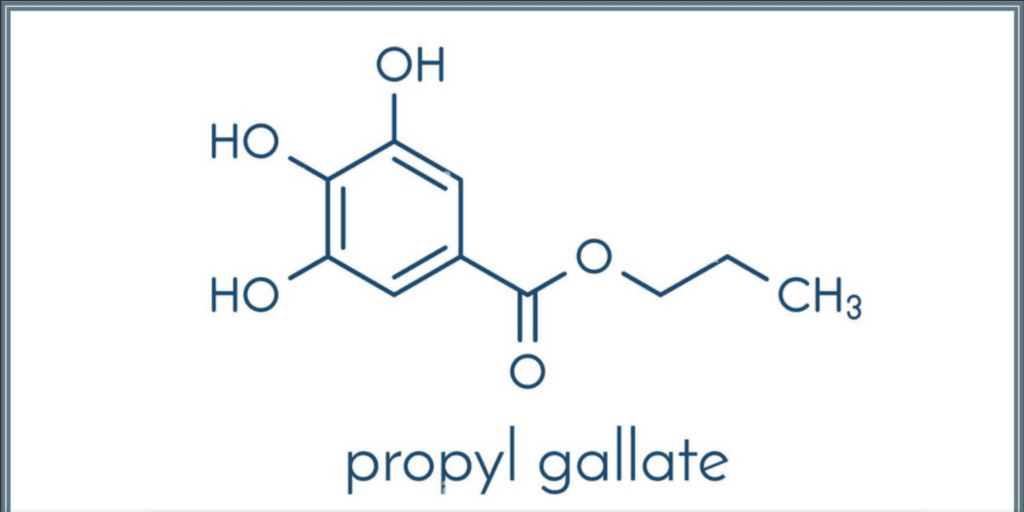The effects of Propyl Gallate are addressed carefully in this article. Propyl gallate is a synthetic compound used in the cosmetics and pharmaceutical industries in addition to being added to food. It comes in the formation of a white, crystalline powder. Propyl gallate is a chemical that can be found in a wide variety of processed meat products, mayonnaise, soup mixes, microwave popcorn, chewing gum, and frozen entrees.
Propyl Gallate helps prevent the rancidity of oils in food by acting as an antioxidant, preventing oxygen molecules from reacting with them. An alternate name for propyl gallate is E310.
Propyl gallate is added to a variety of products—including foods, hair products, adhesives, cosmetics, and lubricants—to prevent the oxidation of oils and fats contained within those products. In fluorescence microscopy, it is utilised in the roles of both an antioxidant and a triplet state quencher.
Facts about Propyl Gallate
Propyl gallate is sometimes combined with the potentially carcinogenic preservatives BHA and BHT in order to increase its effectiveness. It may also affect the functions of the kidneys and the liver.
Gallic acid, also known as 3,4,5-trihydroxy benzoic acid, has an n-propyl ester called propyl gallate. Although it is very weakly soluble in water, it dissolves easily in ethanol, oil, ethyl ether, lard, and aqueous solutions of polyethylene glycol, also known as PEG ethers of cetyl alcohol. Currently, Propyl Gallate can be found in a maximum concentration of 0.1% in 167 different cosmetic items where it serves as an antioxidant.
Causing cancer is one of the effects of Propyl Gallate. A possible link between propyl gallate and cancer has been found in animal research that included rats.
In the United States, Propyl Gallate is allowed in foods at a maximum concentration of 0.02% of the fat or oil content, according to the FDA’s list of substances that are Generally Recognised As Safe (GRAS) for usage. A concentration of 0.1% or less of Propyl Gallate has been deemed fine for application in personal care products and cosmetics by the CIR.
More news about Propyl Gallate
In the high-dose group, the haematopoietic system was affected by propyl gallate. This was shown by changes in haematological parameters like haemoglobin, haematocrit, red blood cells, and morphological changes in the spleen, which is called extramedullary haematopoiesis.
Some differences based on gender were seen, such as slower growth in males, an increase in the weight of the adrenal glands and urinary proteins, and a decrease in the amount of Hb in the blood. On the other hand, both males and females showed a decrease in the activity of the CYP1A-mediated enzyme 7-ethoxyresorufin O-deethylase (EROD) in the liver, while the activities of uridindiphospho-glucuronyltransferase (UGT) and glutathione S-transferase (GST) went up.
Stomach and skin irritability are included in the effects of Propyl Gallate. Propyl gallate is a skin irritant in addition to being an irritant to the eyes.
Wikipedia says that recent studies have shown that Propyl Gallate, like other xenoestrogens, can act like oestrogen. This could lead to male organisms taking on female traits, which increases the risk of cancer in estrogen-sensitive tissues like the ovary, prostate, breast, etc.
Final thoughts
According to Wikipedia, it is an “ester produced by the synthesis of gallic acid with propanol” that is used to prevent oxidation in oils and fats used in food and skin care products. Formulas lose their efficacy if oxidation causes rancidity, viscosity changes, colour changes, and degradation of active components.
The effects of Propyl Gallate include allergic reactions that impact breathing. Inhalation of the substance presents a risk and should be avoided.
Propyl gallate has received a clean bill of health from the Food and Drug Administration (FDA), but in some nations, it is either prohibited or subject to rigorous limitations. Unfortunately, Propyl Gallate is not a widely used additive. Check the ingredient labels of products you suspect might contain it and attempt to keep away from those foods.
Reduce your consumption of processed foods to lower your exposure to potential food additive risks. When possible, fresh or frozen produce should be purchased and served. Plastic should be avoided whenever feasible, although glass and stainless steel are preferable when handling hot foods during preparation and serving.



